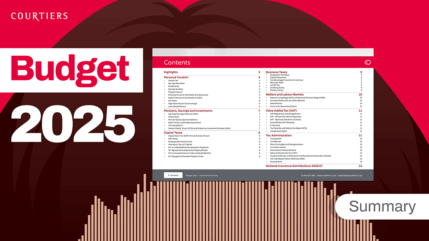Many buy-to-let property owners will be aware of successive steps taken by the government to generate additional tax revenue from the sector. The latest in a long list of legislative changes has just been introduced, effective from 6 April 2020.
Key Takeaway
If the exchange of contracts on a qualifying sale of a second property you own takes place on or after 6 April 2020, gains may well have be reported to HMRC under a new 30 day reporting and payment regime. HMRC has implemented online technology to facilitate this, but there are restrictions under certain conditions.
Before we go further it’s important to note that while we’re focusing here on buy-to-let, this new legislation can also apply to second homes and generally to any property not used as the seller’s main residence.
How things have changed
To offer some perspective of where we are now, let’s look back at how this sector became so over-inflated, attracting the attention of successive Chancellors who introduced ever more complex ways to tax buy-to-let landlords’ income and capital gains.
At the beginning of this century, the popularity of buy-to-let as an investment grew exponentially as private landlords scooped up properties against a backdrop of seemingly ever-increasing property prices. In conjunction with falling interest rates, those looking for diversification from traditional equity investments thought they had found an ideal home for their money.
With a willing mortgage industry happy to lend, it seemed a perfect fit. The recent history of the buy-to-let mortgage sector shows that, at its peak in 2007, around 183,000 buy-to-let mortgages were approved according to the trade body UK Finance. However, by 2018 that figure had fallen dramatically and the Mail Online’s This is Money reported that by 2018 approvals had ‘plunged below 70,000’: a fall of around 60%.
The reasons behind this have been well publicised, not least of which was the government of the day announcing measures to rein in the buy-to-let market back in 2015, amid fears that the growth in the sector was pushing up property prices for struggling first-time buyers. Ask any millennial unable to save enough to buy their first home and they would no doubt agree.
First came legislation in April 2016 which introduced an extra 3% stamp duty for those buying a property that was not to be their main home (England & N Ireland only). At the same time further legislation was brought in:
- The 10% Wear and Tear Allowance was replaced by the far less generous Replacement Relief.
- Mortgage interest relief for landlords has been reducing gradually since 2017 being withdrawn entirely at the beginning of the current tax year.
- From 2016/17 any gain (profit) on the eventual sale of a buy-to-let property attracted an 8% capital gains tax surcharge in addition to the 10% and 20% bands applicable to basic and higher rate taxpayers respectively.
The latest legislation to come in to effect on 6 April this year was first announced by then Chancellor George Osborne (remember him?) in his Autumn Statement in 2015.
Until the current tax year, gains made from the sale of a buy-to-let property would be declared in a self-assessment return for the corresponding year. Tax on any gain payable after deduction of allowances (sale costs, fees etc) was not payable until either January or July the following year under the payments on account scheme.
For example a gain made in May 2018 would be reported in the 2018/19-self assessment return with any tax due payable in January and July of 2020.
The new legislation & online service
From 6 April 2020, there’s a fundamental change to this legislation. If the exchange of contracts on a qualifying sale takes place on or after 6 April 2020 gains must be reported to HMRC under a new 30 day reporting and payment regime.
Her Majesty’s Revenue and Customs (HMRC) has spent the first three months of 2020 ensuring that their online Capital Gains Real Time Service is up and running to allow those with gains to report (or their accountants) to report them and pay any tax due online. To use the service, individuals will need a Government Gateway user ID and password.
There are different steps to be followed if you are using an accountant and you should liaise with them beforehand to ensure they are set up to use the service on your behalf.
The key to managing the new reporting and payment requirements, whether submitting them yourself or through your accountant, is to ensure that all the relevant detail which will be needed is prepared before reporting which must be done within 30 days of the completion date.
Information needed would include:
- address and postcode of the property sold
- date the property was acquired
- date when contracts were exchanged when selling or disposing of the property
- date the seller stopped being the property’s owner (completion date)
- acquisition value of the property
- value of the property on disposal
- costs of buying, selling or making improvements to the property
- details of any tax reliefs, allowances or exemptions the seller is entitled to claim
(This list is not exhaustive but covers the key information required).
One feature of using the Real Time Service is that any tax calculated as payable after entering all the relevant detail is to be paid at the same time as submitting the return. Therefore it would be essential to work out any calculation (gains or losses) before you start the process.
It’s worth noting that if you are already registered for self-assessment and submitting a regular self-assessment return, you should continue to do so. The Real Time Service is not a substitute for an annual self-assessment return but rather, it allows HMRC to collect CGT due more promptly than if taxable gains are included only at the end of the tax year.
Details submitted through the Real Time Service still need to be included in the appropriate year’s self-assessment return. This is how any allowable losses can be applied for example where they occur later in the tax year for any other disposal and allows any over-payment to be calculated by HMRC.
It goes without saying that late filing and late payment penalties will apply, and consequent interest will also continue to be charged.
Online Service Restrictions
- The online service is for UK tax residents only.
- If you’re non-resident and sell a residential property in the UK there is a different procedure to follow and you should contact HMRC for guidance.
- The service is not geared for those acting as a personal representative or executor of someone who has died and needing to report gains or losses for the tax year of death. A hard copy of the form will need to be completed, available from HMRC by request.
Summary
While HMRC is keen to implement new procedures for efficient tax collection, this new legislation puts pressure on the taxpayer to offer up prompt and accurate information.
If this new legislation is likely to affect you in the current tax year or future tax years, your Courtiers adviser will be able to guide you through the process.













